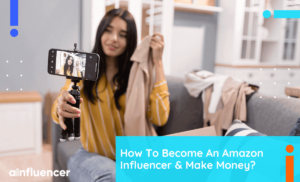It’s very interesting to know that all of us have probably participated in word-of-mouth marketing (AKA WOMM) at least once. How? When you buy something and the thing you purchased turns out to be exactly what you wished for you’ll probably introduce it to others and talk about its features. And they’ll ask you some questions about it.
Let’s say you buy a new phone and tell your friends about the amazing quality of its camera and the durability of its battery. You are not trying to persuade them to buy this phone. But your words may push them towards the product you have purchased naturally.
The things we explained are the foundation of word-of-mouth advertising. But how can you use the power of WOMM to your advantage? We are here to help you with that.
Using Instagram and TikTok influencers is one of the fastest ways to utilize word-of-mouth marketing to attract new customers and influencer marketplaces such as Ainfluencer are ready to help. Ainfluencer is a 100% free influencer marketing platform that helps you find the perfect influencer for your marketing campaign. For more details, try Ainfluencer for free.
What Is Word of Mouth Marketing?
Word-of-mouth marketing is the process of actively encouraging customers to promote the brand organically throughout their daily conversations. In other words, to execute WOMM you need to create enough satisfaction and excitement in your customers that they start spreading positive words about your brands, product, or services during their natural interactions and conversations.
Since consumers are more likely to trust suggestions from family and friends than any other channel, word-of-mouth advertising performs more effectively and encourages other potential customers to choose you over your competitors.
Why Word of Mouth Marketing Is Important?
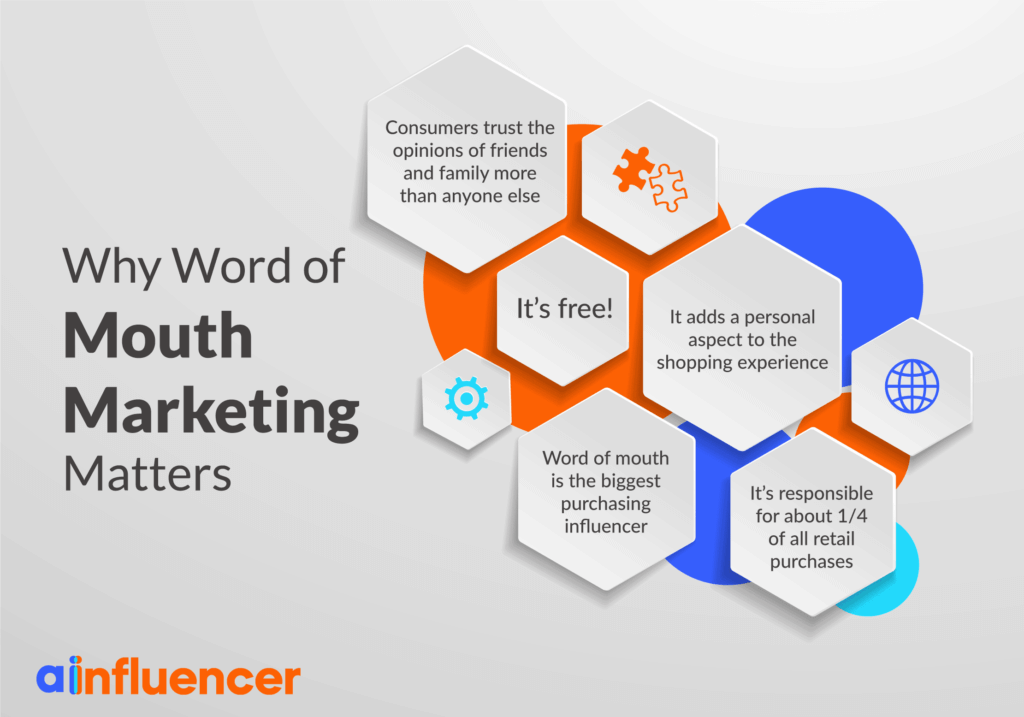
Gaining the consumers’ trust is one of the most important aspects of marketing. Therefore, businesses use different means to be trustworthy for customers such as using influencers through influencer marketing platforms.
Influencers are familiar faces to most people so their words are very persuasive. But, friends, family, classmates, and colleagues are even more familiar and consequently, more trustworthy. This is the most important point about word of mouth marketing.
In addition to the fact that people trust each other more than they trust brands, there are other benefits to word of the mouth advertising:
- Cost-effectiveness: If you can create a pleasing user experience for your customers, word-of-mouth marketing will be free. Even if you try to use WOMM actively, this type of advertising is still much more affordable than other digital marketing types.
- Increased Reach: Word of mouth can spread rapidly and organically, reaching a wide audience without the need for extensive promotional efforts. As satisfied customers share their experiences with others, the message can quickly reach new potential customers.
- Longevity: When one customer spreads the positive word to others, they’ll also continue to share the message with others. This may result in ongoing referrals long after the first customer has had interaction with you. And that one customer can singlehandedly increase your number of customers among their group of friends.
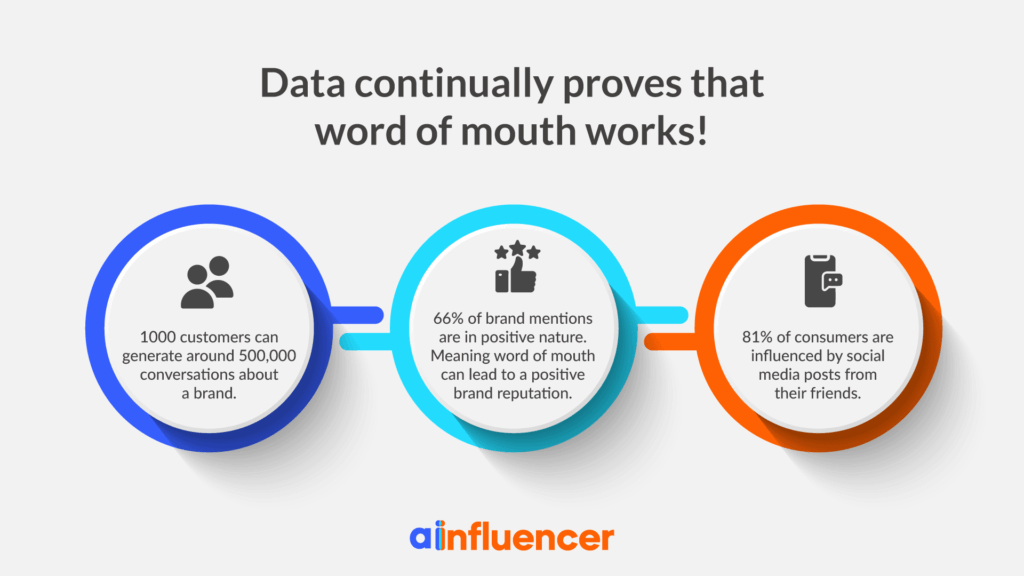
9 Proven Word of Mouth Marketing Strategies
Different approaches can be taken to execute word of mouth advertising. Using different strategies together can increase the WOM marketing effectiveness. Here are 9 different strategies for word of mouth marketing.
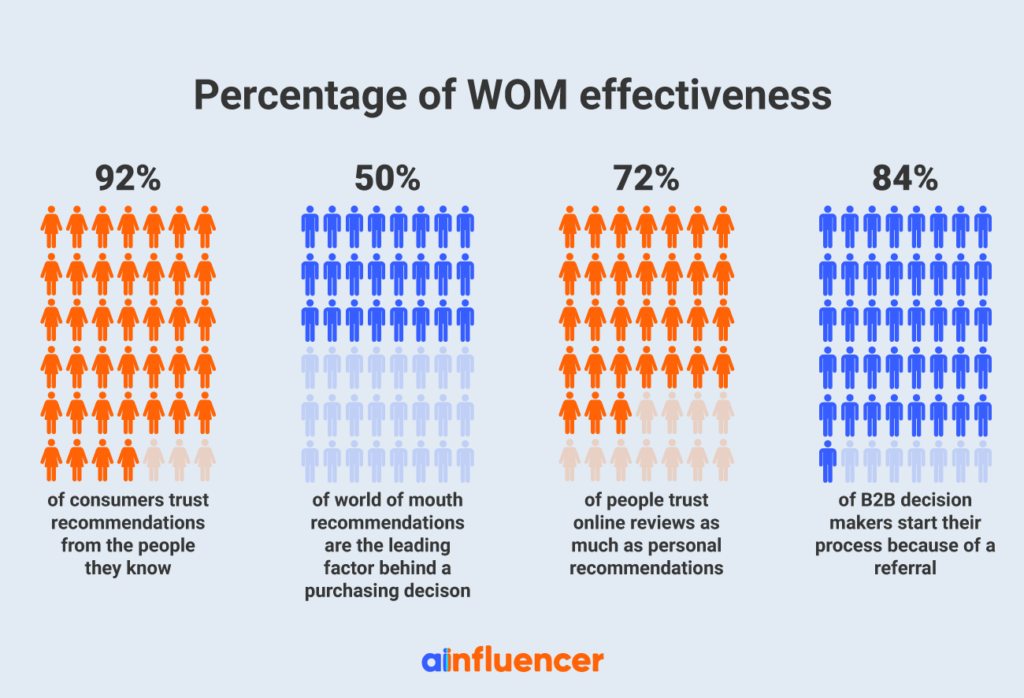
1. Keep Your Costumers Satisfied
The best strategies for word of mouth marketing is to execute it organically and provide your customers with everything they need. If the consumer receive a good first impression about your brand, not only they keep coming back, they also introduce you to others and act as brand ambassador.
Remember to be always respectful towards your customers and do your best to satisfy their needs. But don’t stop there. You should always take after sales service seriously and answer to their feedbacks. Giving customers attention after they have purchased from you makes them feel valued.
This will also help you build trust between you and consumers. Therefore, when they come to you for something, they know that your brand is going to offer the best options and even if they don’t make the best choices while shopping, you’ll be there for them.
2. Talk to key opinion leaders and influencers in your field
Those who are considered influencers have a sizable fan base and the ability to sway the opinions and actions of their followers.
A trusted opinion leader’s endorsement is the most effective form of advertising because of the credibility they’ve already earned in their niche.
Ainfluencer is an influencer marketplace where companies and influencers can connect to strike mutually beneficial deals that benefit both parties. If you’re interested in learning more about how you can find the ideal influencers for any given niche market, have a look at Ainfluencer. Our marketplace is one of the best and easiest ways to find Instagram influencers for your next campaign.
Ainfluencer is free of cost and easy to use. Not to mention every transaction you do in the app is completely secure and safe.
3. Think about imposing some sort of exclusivity
Think about restricting access to your new product or service at launch. If you want useful input from beta testers, you should invite influential members of your community.
Then, they can spread the word to their influential friends and family, who will hopefully buy your goods and spread the word for you.
When people hear about your product, it’s likely to be from those who could actually benefit from it. In addition, they will hear about it from a trusted source, such as a member of their own family, a close friend, or a colleague at work.
4. Upload customer reviews of your products on your website
Having customers provide feedback on products, services, etc., right on your website could be a massive boon for your business.
If you run an online store or a tech business that sells a variety of products, you’ll find this to be extremely helpful.
5. Create a tight-knit network on your preferred social media platform
This necessitates research into the preferred modes of expression within your intended demographic. Where can I find them online? Maybe it’s not what you’re expecting. You should survey your target audience to see if they prefer Facebook or a smaller, more specialized social network like Quora.
However, nuance is essential for constructing a strong social media community. Identify the tone that best suits the situation, and then ask yourself:
- How should one best communicate with them?
- Are they always serious and want you to get right to the point?
- Is it just a place to have a chat?
If you want to be genuine friends with the people you’ve connected with online, you need to make monitoring and engaging with your community a regular part of your routine. You need to ensure that their success is tied to yours and vice versa. This is how you establish a fan base that will not only speak for you but also shout for you.
6. Promote content created by users (UGC)
User-generated content (UGC) refers to information regarding a company’s services or goods that have been produced and distributed by its end users. Sincerity is reassuring, confidence is bolstered, and new marketing opportunities are presented, which gives marketers extra collateral to work with.
71% of customers agree that user-generated reviews make them feel more secure in their decision to purchase a particular product over another.
7. Acquire expert knowledge of your offerings, business, and field
Be well-versed in your field and your product inside and out. The best way to promote your products through word of mouth is to involve everyone from the marketing department to customer service and development.
One last thing: make sure you “understand” your firm and its mission. Is your company taking a stand on the major problems facing its sector? Do you have an idea of what your rivals are doing and how they feel about the issues that arise?
Prospects and customers may ask you questions about any part of your product or service, company, or industry. That’s what it takes to be a leader in your field, and those are the qualities that people will remember and spread the word about. You can’t expect others to risk their good name for you if they don’t believe in you and respect your expertise in the industry.
8. Determine the influential members of the community
If you’ve established a solid network of friends and acquaintances, you probably already know who the key players are. Nonetheless, it’s important to keep an eye out for thought leaders beyond your immediate sphere of influence.
It is your responsibility to introduce yourself to influential people around the globe who could use what you have to offer. Influencers are typically bloggers or creators of original content, and they have a significant social media following and are always up-to-date on the latest news because of these activities. If you can win them over, you may leverage their influence to spread the word about your wares.
9. Inquire about users’ experience with the business and any suggestions they may have
41% of consumers believe they trust online reviews more when they include photographs, keywords, and other visual cues.
As was mentioned before, potential customers will be wary if there aren’t enough substantial reviews to go on. Having more reviews is a tried and true method of gaining the confidence of your target audience.
Just like with user-generated content, sometimes all it takes to score reviews is to ask. This is most conveniently done via email because it is not obtrusive.
Each purchase is a possible opportunity to earn a much-needed review since many brands use post-buy autoresponders to ask for feedback automatically.
The way you solicit feedback, though, is crucial. More than just a happy smile, you should consider offering some incentives (think: discounts or free shipping). Customers’ time is valuable, therefore offering a discount in exchange for a positive review is a worthy investment.
Conclusion
In terms of viral potential and efficiency, WOMM is unparalleled by virtually all other marketing strategies. Don’t discount the influence of referrals and recommendations from satisfied customers as a marketing strategy.
The word of a friend or family member carries more weight than that of a stranger. When people they trust endorse your items, they are more likely to buy them themselves.
The best approach to take advantage of this is by utilizing various forms of word of mouth advertising as mentioned above.
A “word of mouth” strategy is a form of marketing that aims to get people talking about a brand’s products or services. Examples include giving away free products, establishing programs in which brand advocates spread positive word of mouth, and making an impression on key influencers and consumers.
WOM marketing, also known as word-of-mouth marketing, takes place when satisfied clients freely and favorably discuss a company’s goods or services amongst themselves. It’s a type of marketing where happy customers advocate for a business by telling others about their positive experience.
The spread of good reviews may do wonders for both your brand’s visibility and your ability to draw in new customers. This fresh and natural form of marketing can help companies strengthen ties with their existing clientele while also attracting new ones.
Every year, word-of-mouth advertising accounts for 13% of all purchases and generates $6 trillion in revenue worldwide. Product sales increase by a factor of five when a satisfied customer recommends a product or service to a potential buyer instead of using traditional advertising.



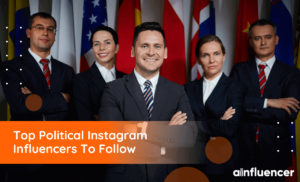

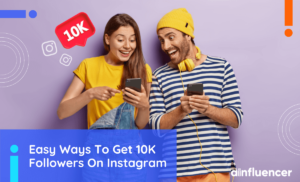
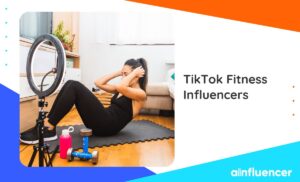
![Read more about the article 55 Body Positive Influencers On Instagram [2023 Non-Celebrity]](https://blog.ainfluencer.com/wp-content/uploads/2021/02/Body-Positive-Influencers-On-Instagram-Non-Celebrity-300x182.png)
